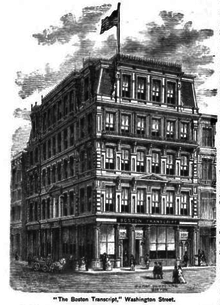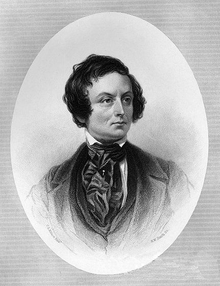Boston Evening Transcript
 Boston Evening Transcript, November 5, 1903 | |
| Type | Daily newspaper |
|---|---|
| Format | Broadsheet |
| Owner(s) | The Boston Transcript Company |
| Founded | July 24, 1830[1] |
| Language | English |
| Ceased publication | April 30, 1941 |
| Headquarters | 324 Washington Street (Corner of Milk Street and Washington Street), Boston, Massachusetts |
The Boston Evening Transcript was a daily afternoon newspaper in Boston, Massachusetts, published from July 24, 1830, to April 30, 1941.[2]
Beginnings[]
The Transcript was founded in 1830 by Henry Dutton and James Wentworth of the firm of Dutton and Wentworth, which was, at that time, the official state printer of Massachusetts.[3] and Lynde Walter who was also the first editor of the Transcript.[4] Dutton and Wentworth agreed to this as long as Walter would pay the expenses of the initial editions of the newspaper.[4]
In 1830 The Boston Evening Bulletin, which had been a penny paper, ceased publication. Lynde Walter decided to use the opening provided to start a new evening penny paper in Boston. Walter approached Dutton and Wentworth with the proposal that he would edit the paper and that they would do the printing and circulation.[4]
The Transcript first appeared on July 24, 1830,[1] however after three days Walter suspended publication of the paper until he could build up his patronage. After Walter canvassed the city to better develop the paper's business The Transcript resumed publication on August 28, 1830.[5]
After Lynde Walter died, his sister, Cornelia Wells Walter, who had been the Transcript 's theatre critic, became, at 29, the editor of the Transcript,[6] the first woman to become the editor of a major American daily. Cornelia Walter served as the editor of The Transcript from 1842 to 1847.[7]
Great Fire[]


The Transcript 's offices were destroyed in the Great Boston Fire of 1872. After the Great Fire The Transcript 's offices on Washington Street were rebuilt and expanded.[8]
Literary influence[]
In 1847 the poet Epes Sargent became editor of the paper. Many literary and poetic works debuted in the Transcript's pages.
An early version of "America the Beautiful" by Katharine Lee Bates first appeared in The Boston Evening Transcript on November 19, 1904.[9]
Hazel Hall (poet)'s first published poem "To an English Sparrow", first appeared in The Transcript in 1916.[10]
Features and columns[]
Features and columns included: "Suburban Scenes", "The Listener", "The Nomad", "The Librarian", "Saturday Night Thoughts", as well as extensive book reviews and music criticism. The Transcript also had a Washington bureau, a college sports pages and a department of Bridge. In addition The Transcript had a well known genealogy column.
Harvard Medical School's first U.S. animal vivisection lab raised concern from then editor-in-chief Edward Clement, and the paper subsequently ran a series of anti-vivisection editorials.[11]
In the summer of 1940 when Britain faced invasion in World War II, children were being evacuated overseas under a British Government scheme known as the Children's Overseas Reception Board. The readers of the Boston Evening Transcript readily responded and agreed to sponsor a group of children. A group of 48 children left England on RMS Scythia (Cunard Line) 19,730 tons, from Liverpool on 24 September 1940 bound for Boston.[12]
Genealogical columns[]
Because of the genealogy column The Transcript is of value to historians and others. Gary Boyd Roberts of the New England Historic Genealogical Society noted:
The Boston Evening Transcript, like the New York Times today, was a newspaper of record. Its genealogical column, which usually ran twice or more a week for several decades in the early twentieth century, was often an exchange among the most devoted and scholarly genealogists of the day. Many materials not published elsewhere are published therein.[13]
Contributors[]
- Justin Brooks Atkinson, police reporter, assistant to the drama critic, H. T. Parker, (1919–1922).
- David Washburn Bailey, sports reporter and drama critic, assistant dramatic editor (1922–1928).
- Clarence W. Barron, Transcript reporter (1875–1887).
- William Stanley Braithwaite, (1906–1931) served as literary editor.
- Virginia Lee Burton, sketch artist.[14]
- Joseph Edgar Chamberlin, editor.
- , editor-in-chief (1881–1906) and co-founder of the New England Anti-Vivisection Society (NEAVS).
- Albert C. Dieffenbach, editor of religion (1933–1941).
- Edward Downes, music critic.
- , literary editor (1894–1938).
- Dr. Herbert H. Fletcher, editor of religion, associate managing editor, and founder and sole editor of The Churchman Afield department of The Saturday Evening Transcript.
- Jeannette Leonard Gilder, writing under the pen name "Brunswick", Gilder was the New York correspondent of the Transcript[15]
- John A. Holmes, served as poetry editor for eight years.
- Olga Van Slyke Owens Huckins, literary editor (1939 to 1941).[16] Huckins letter to Rachel Carson inspired the book Silent Spring.[17][18]
- Charles E. Hurd, literary editor (1875–1901), originated and conducted the Notes and Queries; and Genealogical departments, contributed to the Art, Dramatic and Editorial departments.[19]
- Francis Henry Jenks, music and dramatic editor 1881–1894.[20]
- Franklin Jordan, aviation editor.
- Howard Mumford Jones, book editor.[21]
- Henry Cabot Lodge, Jr., reporter.
- Kenneth Macgowan, drama critic.
- John P. Marquand, was a staff writer on the paper and later on its bi-weekly magazine after he graduated from Harvard College.[22]
- John U. Monro, journalist and later dean of Harvard College[23]
- Joseph Palmer, acting editor (1840–1842).
- Henry Taylor Parker, music, dance and drama critic (1905–1934).[24]
- Edmund Pearson, (1880–1937) writer of the column, The Librarian from 1906 to 1920.
- Lucien Price, (1907–1914) assistant music and drama critic, editorial writer, and journalist.
- Epes Sargent, editor.
- Paul Secon, music critic[25] who also co-founded the Pottery Barn.
- Nicolas Slonimsky, music writer.
- Cornelia Wells Walter, editor (1842 to 1847), and theater critic.
- Anne Wiesman society editor.
- Lynde M. Walter, editor (1830–1840), and one of the Transcript's founders.
In popular literature[]
"The Boston Evening Transcript" is also the title of a poem by T. S. Eliot which reads:
- The readers of the Boston Evening Transcript
- Sway in the wind like a field of ripe corn.
- When evening quickens faintly in the street,
- Wakening the appetites of life in some
- And to others bringing the Boston Evening Transcript,
- I mount the steps and ring the bell, turning
- Wearily, as one would turn to nod good-bye to Rochefoucauld,
- If the street were time and he at the end of the street,
- And I say, "Cousin Harriet, here is the Boston Evening Transcript."
See also[]
- Boston Daily Advertiser
- Boston Herald
- The Boston Globe
- The Boston Journal
- The Boston News-Letter
- The Boston Post
- The Boston Record
References[]
- ^ Jump up to: a b Chamberlin, Joseph Edgar (1969), The Boston Transcript: A History of Its First Hundred Years, Freeport, NY: Ayer Publishing, p. 11, ISBN 0-8369-5146-8
- ^ Jump up to: a b "BOSTON TRANSCRIPT TO QUIT WEDNESDAY; Five-Cent Price Fails to Save Newspaper, Approaching Its 111th Anniversary PROFITABLE UNTIL 1929 Patron of Arts and Sciences Began Decline With Slump in 'Lush Financial Advertising'", The New York Times, New York, NY, p. 23, 24 April 1941
- ^ King, Moses (1881), King's Handbook of Boston 4th ed., Cambridge, MA: M. King, p. 263
- ^ Jump up to: a b c Chamberlin, Joseph Edgar (1969). The Boston Transcript: A History of Its First Hundred Years. Freeport, NY: Ayer Publishing. p. 10. ISBN 0-8369-5146-8.
- ^ Chamberlin, Joseph Edgar (1969), The Boston Transcript: A History of Its First Hundred Years, Freeport, NY: Ayer Publishing, p. 16, ISBN 0-8369-5146-8
- ^ Chamberlin, Joseph Edgar (1969), The Boston Transcript: A History of Its First Hundred Years, Freeport, NY: Ayer Publishing, p. 69, ISBN 0-8369-5146-8
- ^ Madison, D. Soyini (2006), The SAGE Handbook of Performance Studies, Thousand Oaks, CA: SAGE, p. 119, ISBN 0-7619-2931-2
- ^ History of the Great Fire of Boston by Col. Russell H. Conwell, 1873
- ^ McLaughlin, Jeff (July 22, 1993), "A century of 'spacious skies'; Bates' 'America the Beautiful' has endured time and tinkering", The Boston Globe, Boston, MA, p. 21 Metro Region Section
- ^ Terry, John (October 10, 2004). "Oregon's Trails: Hazel Hall's Poems a Prism to Life and Why this is so". The Oregonian. Portland, Oregon. p. A23 Northwest; Oregon & The West Section.
- ^ "To Right a Wrong: That Is the Purpose of Anti-Vivisectionists". Boston Evening Transcript. 12 March 1901.
- ^ "The Wartime Memories Project - Evacuees". Archived from the original on 2011-08-11. Retrieved 2011-12-09.
- ^ New England Historical Genealogical Society: Genealogical Thoughts by Gary Boyd Roberts Archived September 27, 2007, at the Wayback Machine
- ^ Glenn, Joshua (June 15, 2008), Icons of the 20th century, in Lego, Boston, MA: The Boston Globe., p. C10 Ideas Section
- ^ The National Cyclopaedia of American Biography (1898), The National Cyclopaedia of American Biography. Being the History of the United States as Illustrated in the Lives of the Founders, Builders, and Defenders of the Republic Vol. VIII, New York, NY: J.T. White, p. 441
- ^ Special to The New York Times (July 13, 1968), "Olga Huckins, Ex-Editor At Boston Transcript, 67", New York Times, New York, NY, p. 27
- ^ Matthiessen, Peter (2007), Courage for the Earth: Writers, Scientists, and Activists Celebrate the Life and Writing of Rachel Carson, Boston, MA; New York, NY: Mariner Books, p. 135, ISBN 978-0-618-87276-3
- ^ Himaras, Eleni (May 26, 2007), Rachel's Legacy - Rachel Carson's groundbreaking 'Silent Spring' was inspired by Duxbury woman, Quincy, MA: The Patriot Ledger.
- ^ Colby, Frank Moore (1911), The New International Year Book: A Compendium of the World's Progress for the year 1910, New York, NY: Dodd, Mead and Co., p. 356
- ^ De Bekker, Leander Jan (1924), Black's Dictionary of Music & Musicians: Covering the Entire Period of Musical History from the Earliest Times to 1924, London, UK: A. & C. Black, ltd., p. 296
- ^ Wier, Albert Ernest (1943), Thesaurus of the Arts: Drama, Music, Radio, Painting, Screen, Television, Literature, Sculpture, Architecture, Ballet, New York, NY: G.P. Putnam's Sons, p. 360
- ^ Holman, C. Hugh (1965), John P. Marquand, Minneapolis, MN: U of Minnesota Press, p. 10, ISBN 0-8166-0350-2
- ^ Severo, Richard (2002-04-03). "John U. Monro, 89, Dies; Left Harvard to Follow Ideals". The New York Times. ISSN 0362-4331. Archived from the original on 2021-05-10. Retrieved 2021-05-10.
- ^ Kisselgoff, Anna (January 11, 1981), "Dance View;CARL VAN VECHTEN'S CENTENARY", New York Times, New York, NY, Section 2; Page 8, Column 2
- ^ Miller, Stephen (March 6, 2007), Paul Secon, 91, Founded Pottery Barn, New York, NY: New York Sun, p. 10
Archives and records[]
- Boston Evening Transcript records at Baker Library Special Collections, Harvard Business School.
External links[]
| Wikimedia Commons has media related to Boston Evening Transcript. |
- Boston Evening Transcript
- Defunct companies based in Massachusetts
- Defunct newspapers published in Massachusetts
- Newspapers published in Boston
- Publications disestablished in 1941
- Newspapers established in 1830
- Evening newspapers
- Daily newspapers published in the United States
- 1941 disestablishments in Massachusetts
- 1830 establishments in Massachusetts
